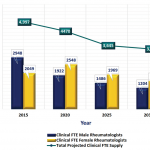The rheumatology workforce is unevenly distributed around the country as well, he said. “In the Northeast, there are 1,262 rheumatologists, which represents 21% of our adult rheumatologists, and 26,719 adult patients per rheumatologist,” said Dr. Battafarano. “Shift your attention to another region—the Southeast, [and] you will find that 11% (or 698 total) of our rheumatologists are down there. But the ratio of patients to rheumatologist is much different: 60,087 adult patients per rheumatologist. Access to care in that area is already more strained.”
Pediatric rheumatologists also are unevenly distributed around the country, with 24.8% in the Northeast and 2.4% in the Southwest, the study noted.
How to Meet the Challenge
Panelists shared some ideas to address workforce shortages and improve access to care:
Redistributed patient care: Primary care physicians could manage more patients—those with OA or gout and who don’t require complex, multi-treatment care—without rheumatology consultation, said John FitzGerald, MD, PhD, interim chief of rheumatology at the University of California Los Angeles. “But there are shortages in primary care, too, so simply pushing more patients back on primary care will not be an adequate solution,” he said.
Invest in NP & PA training: Rheumatologists should reach out to local schools to train and recruit more NPs and PAs, said Kori Dewing, DNP, ARNP, a nurse practitioner at Virginia Mason Medical Center in Seattle. “We can show NPs and PAs that rheumatology is an exciting place to be. If they see this early in their training, they can focus some of their additional training in rheumatology and come out passionate for this career path,” said Dr. Dewing.
New technology: Telemedicine often is touted as a potential way to expand care, but its exact role in rheumatology is uncertain, said Dr. Battafarano. “There have been many successful pilot programs with medical centers at the intrastate level. This is an area that needs to be actively pursued and studied for screening consults, management advice and timely access to rheumatologic care.”
Identify pools of potential rheumatologists: It’s important to learn more about the medical schools and residency programs worldwide that produce our fellows, said V. Michael Holers, MD, head of the division of rheumatology at the University of Colorado, Denver. “We know very little about our prefellowship pipeline. We don’t know, as an academic organization, which medical schools or hospitals overseas are sending fellows to us, so we can model best behaviors. If we support educators, rheumatologists who have access to residents and medical students, they will recruit new rheumatologists into the pipeline,” he said.


